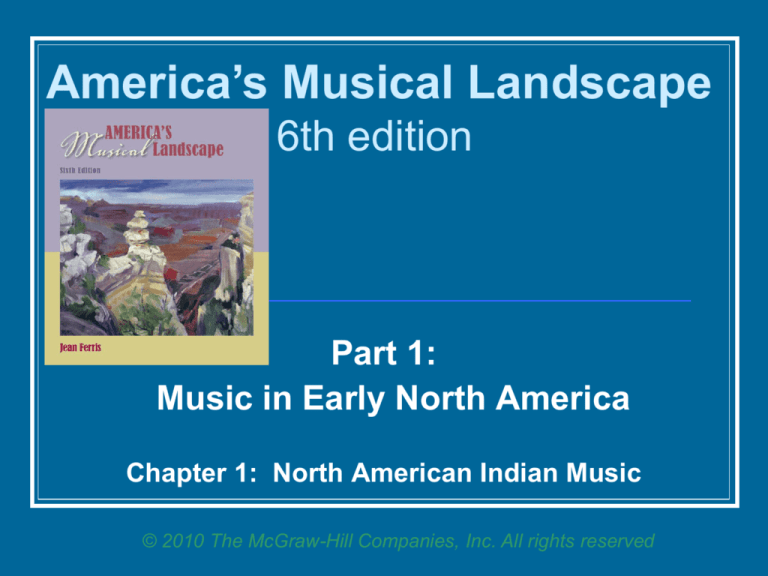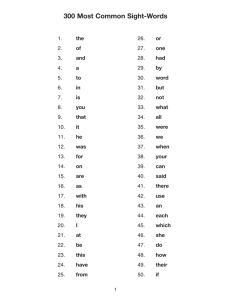
America’s Musical Landscape
6th edition
Part 1:
Music in Early North America
Chapter 1: North American Indian Music
© 2010 The McGraw-Hill Companies, Inc. All rights reserved
Music in Early North America
The Early Years: Historical and Cultural
Perspective
Scholars believe that human experience has always
included music
Music’s sound and its place in society have differed widely
from one time and one culture to another
Even today, people differentiate between “music” and
“noise”
Often disagreeing on which is music and which is noise
© 2010 by The McGraw-Hill Companies, Inc.
All rights reserved.
Part 1: Music in Early North America
Chapter 1: North American Indian Music
2
The Beginnings of Music in America:
Native Americans
Long before the first white settlers or
black slaves touched the North American
shores the people living here were
making music of their own
Today’s descendants of the early
Native Americans retain a strong
reverence for and a sense of
oneness with nature
Expressed within music as in all
their arts, traditional Native
American music and art all had
spiritual and utilitarian
significance
© 2010 by The McGraw-Hill Companies, Inc.
All rights reserved.
Native American Frame Drum
Part 1: Music in Early North America
Chapter 1: North American Indian Music
3
The Beginnings of Music in America:
Native Americans
The Western separation of sacred and
secular concepts has little meaning
among Native Americans
Religion, art, music, poetry are the
inseparable threads—the warp and
woof—of life and culture
Before the twentieth century Native
American cultural expression remained
consistent
Indian Scout, painted by
Alfred Jacob Miller, 1810-1874
During the last century, acculturation
brought about significant changes in
Indian music
© 2010 by The McGraw-Hill Companies, Inc.
All rights reserved.
Part 1: Music in Early North America
Chapter 1: North American Indian Music
4
The Beginnings of Music in America:
European Emigrants
During the sixteenth century, Europeans began to arrive and
settle in North America in large numbers
Bringing musical customs with them
Early seventeenth century: Pilgrims and Puritans in New
England were Protestants
Protests against the Roman Catholic Church included some
concerning the performance of religious music
Puritan Society included sophisticated men and women of keen
wit and high intellect
Including Anne Bradstreet (1612-1672), the New World’s
first poet
© 2010 by The McGraw-Hill Companies, Inc.
All rights reserved.
Part 1: Music in Early North America
Chapter 1: North American Indian Music
5
The Beginnings of Music in America:
Puritan Society
Early New Englanders had little use for art
for art’s sake
But their daily experience was rich in
artistic expression
Example: Graveyards by houses of
worship contained elaborately
carved and decorated headstones
Landscape painting held little
attraction
But portrait painting preserved a
likeness and so was valued
© 2010 by The McGraw-Hill Companies, Inc.
All rights reserved.
Part 1: Music in Early North America
Chapter 1: North American Indian Music
Gravestone in a colonial churchyard
6
The African Experience in Early
America
Even before the Pilgrims’ arrival at Plymouth Rock in 1620,
Africans were being forcibly brought to, and made to work in
the New World
Forbidden to practice their familiar African religious rituals
and to sing songs, dance, and play musical instruments in
their accustomed ways
Slaves attempted to adapt traditional African musical expression
to worship the white people’s Christian god
Slaves integrated music and faith into their daily lives
© 2010 by The McGraw-Hill Companies, Inc.
All rights reserved.
Part 1: Music in Early North America
Chapter 1: North American Indian Music
7
Revolution, in Classical Style
Eighteenth-century Americans of European descent reflected a
strong European influence
European artists had adopted the classical ideals of ancient Greek
sculptors and architects
Perfection of form, balanced designs, relatively restrained
emotional expression
From 1750 to 1820, artists applied these characteristics to
their art: The Age of Classicism
In music, the eighteenth century is known as the Classical Period
This was the era of the American Revolution and the Declaration of
Independence
© 2010 by The McGraw-Hill Companies, Inc.
All rights reserved.
Part 1: Music in Early North America
Chapter 1: North American Indian Music
8
Painting in Eighteenth-Century
America
American artists had more training and sophistication than the folk
artists of the settlers’ period
But their finest works retained an innocence, honesty, and
decorative sense
Distinguishing them from the more elegant European works
of the era
John Singleton Copley (1738-1815)—America’s greatest
colonial artist
Charles Wilson Peale (1741-1827)—The leading artist in
Philadelphia for many years
© 2010 by The McGraw-Hill Companies, Inc.
All rights reserved.
Part 1: Music in Early North America
Chapter 1: North American Indian Music
9
The Effects of Cultures on the
Evolution of American Music
The traditions and practices of all the early inhabitants all affected
American music
Those native to the land; early European arrivals; the slaves
Early music heard in the separated inhabited regions of the
continent reflected highly disparate values and sounds, yet had
elements in common
More likely to be performed by amateurs in intimate settings (not
the concert hall), and often with spiritual connotation
The distinctions we draw between sacred and secular music—and
between high and low art--had little meaning in the early American
experience
© 2010 by The McGraw-Hill Companies, Inc.
All rights reserved.
Part 1: Music in Early North America
Chapter 1: North American Indian Music
10
North American Indian Music: Songs
Music occurred in association with other activities
Dance, religious ritual, prayer, work, recreation
Songs possess strong powers to accomplish a given end, such as
Success in fishing
Healing
Winning a bride
Songs are not thought of as composed
They are believed to have been received in a dream or vision
A song’s owner may sell the song or grant someone else the
right to sing it, or pass on the song in a will
Songs are preserved by oral tradition through generations
© 2010 by The McGraw-Hill Companies, Inc.
All rights reserved.
Part 1: Music in Early North America
Chapter 1: North American Indian Music
11
North American Indian Music: Songs
Texture, Texts
Usually sung by a solo voice or by men and women singing in
unison = Singing the same notes at the same time
There is no harmony in the Western sense, but there may be…
Call-and-response = solo voice alternating with a group
Melodic phrases start on a higher pitch and then descend, similar to
the spoken phrase
A song often consists of many repetitions of one or more phrases or
partial phrases
Songs may be in a native language, or recently, in English
Some texts are vocables = neutral syllables (hey, neh, yeh)
© 2010 by The McGraw-Hill Companies, Inc.
All rights reserved.
Part 1: Music in Early North America
Chapter 1: North American Indian Music
12
Listening Example 2
Yeibichai Chant Song (excerpt)
Listening guide page 22
On the ninth (last) night of the
Night Way ceremony,
Yeibichai appears
accompanied by masked
dancers shaking their guard
rattles, and by the unearthly
call of the gods. The falsetto
tones heard here are
particularly characteristic of
this and of some other
Native American songs
Form: Strophic
Melody: Repeated high-pitched tones interspersed with even higher
cries of indeterminate pitch, producing a rather florid melodic line
featuring dramatic upward leaps
Rhythm: Steady pulse marked by rattle shakes
Text: Vocables punctuated with the distinctive call of the Yei
© 2010 by The McGraw-Hill Companies, Inc.
All rights reserved.
Part 1: Music in Early North America
Chapter 1: North American Indian Music
13
Listening Example 3
Sioux Grass Dance (excerpt)
Plains Indians
Listening guide page 23
Usually referred to today as
a grass dance, because of
the grass braids the
dancers wear at their
waists, this is the stirring
war dance music heard, or
imitated, in countless
western movies
Hear the strong pulsations,
and the falsetto singing.
Form: Strophic, phrase introduced with leader’s call
Melody: Phrases begin high pitched, then descend
Accompaniment: Drums, rattles, observers’ yells
Manner of performance: Two teams of costumed dancers carrying
weapons face each other, imitating battle
© 2010 by The McGraw-Hill Companies, Inc.
All rights reserved.
Part 1: Music in Early North America
Chapter 1: North American Indian Music
14
North American Indian Music: Sound
Instruments
Little music is performed by instruments alone
Sound instruments often support or “hold up” a song
Navajo flute: The main melody-playing instrument
Traditionally used as a courting instrument to persuade a young
woman to marry the player
Percussion instruments are widespread
Especially rattles, rasps, drums
A rasp is made from a long stick of wood into which notches
have been carved, rubbed with another stick or piece of
bone to make a rasping sound
Drums are profuse in variety
© 2010 by The McGraw-Hill Companies, Inc.
All rights reserved.
Part 1: Music in Early North America
Chapter 1: North American Indian Music
15
North American Indian Music:
Contemporary Indian Song
Among the earliest changes to Native American Indian music was
the development of pan-Indian songs
Native American peoples from many tribes, speaking various
languages, met at powwows for dancing, singing, ceremonies
Modern powwows are common on reservations and in cities
Vocables are used to sing powwow songs; vocables…
Unite the people as Native Americans and as members of a
particular tribe
Authenticate ceremonies
Keep people in balance with nature
Often there are visitors from other cultures
© 2010 by The McGraw-Hill Companies, Inc.
All rights reserved.
Part 1: Music in Early North America
Chapter 1: North American Indian Music
16
North American Indian Music:
Professional Musicians
Recent interest in Native American Indian
culture has produced much research of live
and recorded traditional and new Native
American music
Carlos Nakai (b. 1946)
Collaborates with musicians in many fields,
including the concert hall, electronic
techniques, Navajo flute, more
Louis Ballard: Composer, music educator,
journalist of Cherokee, Quapaw, Scottish,
French, English descent
© 2010 by The McGraw-Hill Companies, Inc.
All rights reserved.
Part 1: Music in Early North America
Chapter 1: North American Indian Music
R. Carlos Nakai
17
Image Credits:
Slide 3: Native American frame drum
© C Squared Studios/Getty Images
Slide 4: Indian Scout, painted by Alfred
Jacob Miller, © Corel
Slide 6: Gravestone in a colonial
churchyard, © Corbis
Slide 17: R. Carlos Nakai, © Getty Images
© 2010 by The McGraw-Hill Companies, Inc.
All rights reserved.
Part 1: Music in Early North America
Chapter 1: North American Indian Music
18





